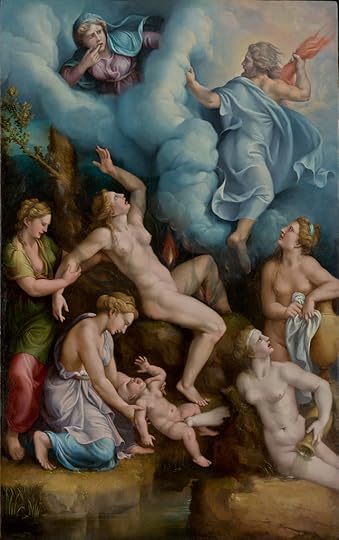 Kalliope’s
Comments
(group member since Aug 28, 2018)
Kalliope’s
Comments
(group member since Aug 28, 2018)
Kalliope’s
comments
from the Ovid's Metamorphoses and Further Metamorphoses group.
Showing 401-420 of 610
 The Pentheus story does not call for pretty images, but I found one which is very beautiful portrayal, not of his being quartered, but of his flight in full terror...
The Pentheus story does not call for pretty images, but I found one which is very beautiful portrayal, not of his being quartered, but of his flight in full terror...An overlooked Swiss painter who had an interesting but complicated life. He was for a while a teacher to a few of the Impressionists.
Fascinating and spooky landscape.
Charles Gleyre. Pentheus hunted by the Maenads. Around 1860-70. Kunstmuseum, Basel.

 There is only one paragraph devoted to the nymph Liriopé, who was raped by the river Cephisus, and who gave birth to Narcissus.
There is only one paragraph devoted to the nymph Liriopé, who was raped by the river Cephisus, and who gave birth to Narcissus.There are a few images of nymphs who could be her, or any other.. but more interesting, paintings of her taking her baby Narcissus to Tiresias, to ask for his future.
Giulio Carpioni. 1660s. Private Collection.
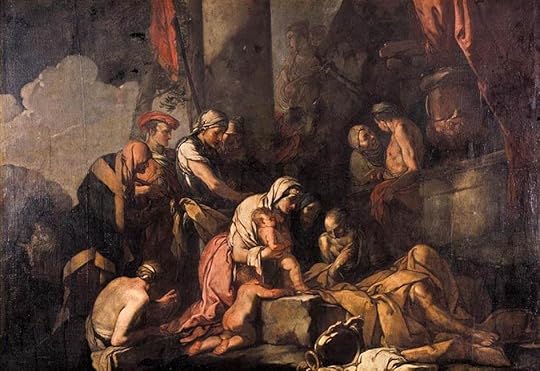
Giovanni Battista Crociato. First half 17C. Private.

Crociato also has a few on the Europa cycle.
 Jim wrote: "
Jim wrote: "Dancers are: Nina Timofeyeva (Diana) & Yuri Vladimi..."
Thank you, Jim... No, he didn't capture much of the story.. but that often happens with ballets.. But for me it is interesting that even the title was there... Classical tales have filtered down to our age, transformed (!!! - so did Ovid himself transform them), cropped, synthesised, mixed etc... Sometimes as vague 'Echoes' (!!).
Yesterday I was at the Thyssen and we were looking at Lichtenstein's Woman in a Bath, which I have seen many times, but yesterday for the first time I added 'the Diana bathing' in the amalgamated tradition of female nudes on which Lichtenstein seems to be drawing his inspiration, or to which he is making (loose) references..
Anyway, this association I made was thanks to our reading of Ovid now...
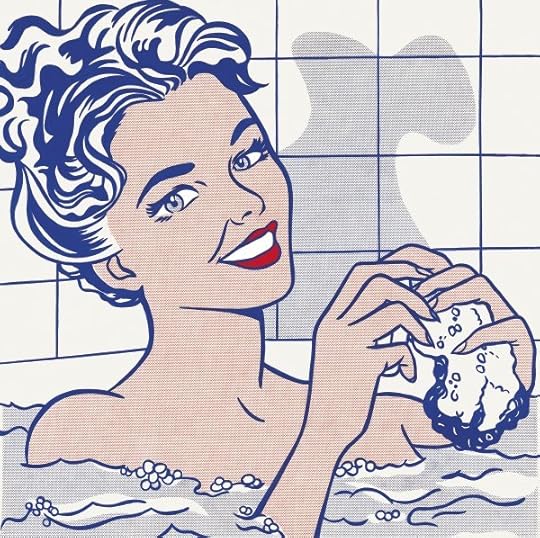
We, the viewers, could be the Actaeon...
 By pure chance I found this 6 minute video on a Ballet piece on Diana & Actaeon.
By pure chance I found this 6 minute video on a Ballet piece on Diana & Actaeon.https://www.youtube.com/watch?v=Naqou...
Dancers are: Nina Timofeyeva (Diana) & Yuri Vladimirov (Actaeon) and the music is by Cesare Pugni. I know nothing about him.
 There are two more Europas I wanted to post.. One came out during a visit with some friends to the Prado museum.. we were looking through a book on the Bilbao museum in the Museum bookshop... I was very happy to suddenly see this among its pages.
There are two more Europas I wanted to post.. One came out during a visit with some friends to the Prado museum.. we were looking through a book on the Bilbao museum in the Museum bookshop... I was very happy to suddenly see this among its pages.Martin de Vos. 1590. Bellas Artes, Bilbao

What I like in this one (another one which follows the Titian composition) is Europa's delicate face, the crispness and clarity in the background (the handling of the paint is completely different to Titian's), the bright pink and yellow, and the way we can see the part of the bull that is inside the water. De Vos was a Flemish but we traveled and lived in Italy (surprisingly he accompanied Bruegel in his journey to Rome).
And I had overlooked the works by one of my favourite painters, Tiepolo.
Gianbattista Tiepolo. 1725. Galleria dell'Accademia.
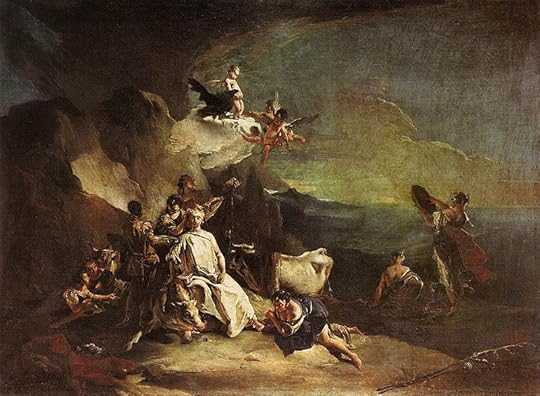
Interesting tonality... no trail of the 'pink' that struck Proust.
Tiepolo, but copy of Veronese (Dresden). ca 1743. National Galleries of Scotland.

 Roger wrote: "
Roger wrote: "Would you care to elaborate a little, Kall? What in particular disconcerts you? The ..."
Roger, if I could elaborate further I would not be disconcerted. I have read through the passage once, and I still have to read the other two editions I am handling.
Hopefully, I will come back to this. But I know I am not the only one in finding this passage disconcerting.
 Two more paintings on Echo or Narcissus & Echo.
Two more paintings on Echo or Narcissus & Echo.On Echo alone, not surprising that the French painter Cabanel, in his academic stand, would chose to depict her...
Alexandre Cabanel. Echo. 1874. Metropolitan Museum.
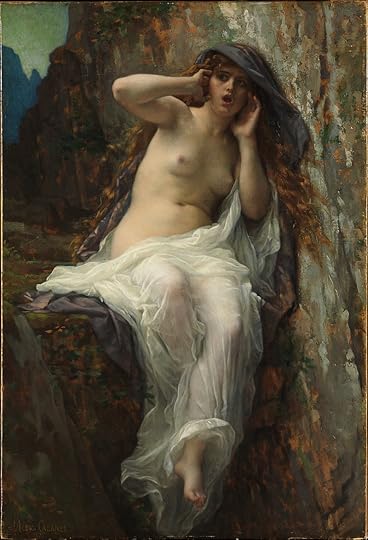
Perfect pose, for her nudity and for her identity.
And then an important one in this iconography.
Nicholas Poussin. 1630. Louvre.
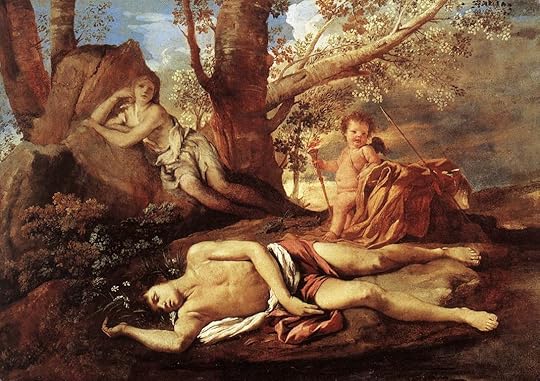
Narcissus already dead (for some reason I imagine him sinking in the pond), a peculiar contemplative Echo and interesting the presence of Cupid... is he blamed for the tragedy?... an 'echo' of the Apollo and Daphne story....
 Jim wrote: "Several of the sources I've looked into claim that Caravaggio did use himself as model for his Bacchus.
Jim wrote: "Several of the sources I've looked into claim that Caravaggio did use himself as model for his Bacchus."
Yes, that is taken to be him. Those very arched eyebrows help to identify him.
As for the Narcissus, although I have read Alberti years ago and don't remember this particularly, I have encountered now a quote of his saying that the first painter was Narcissus. That idea must have perdured during the ages.
(view spoiler)
 The section on Pentheus, and again, the way we arrive at this episode, is very disconcerting.
The section on Pentheus, and again, the way we arrive at this episode, is very disconcerting.I think here it helps, at least it helps me, to think of what Historygirl and RC have said about this chapter dealing with the Thebes cycle (#52 & 56).
At some point I would like to read the Aeschylus and Euripides plays.
But any further clarifications on these and on how Ovid recycles these themes, would be welcome.
 As the pictorial implications of the Narcissus story - as well as the reversal of genders seem to me a very challenging theme for painters.. I have explored a bit more.
As the pictorial implications of the Narcissus story - as well as the reversal of genders seem to me a very challenging theme for painters.. I have explored a bit more. There is, and this one is no surprise, a landscape version by Claude Lorrain, where the story is subsumed in the setting, although Echo trying hard to draw Narcissus's attention will however only get the viewer looking.
Claude Lorrain. 1644. London National Gallery.
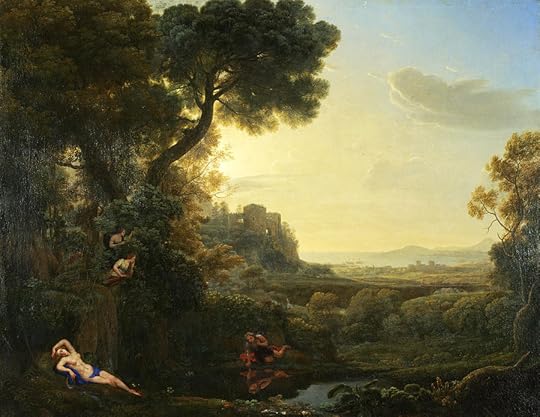
But I was glad to find a painting of Echo alone...
Talbot Hughes. Echo. 1900. Private collection.

And this very interesting version where colour waves seem to allude to reverberating sounds.
Jeanette Lafontine. Contemporary. Saatchi Gallery.
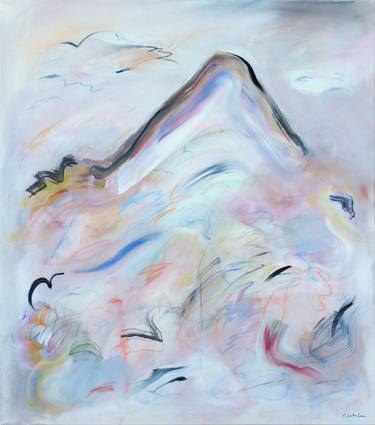
Lafontine is Norwegian, in spite of what her name would make one think. I did not know her work.
 Roger wrote: "..she is right in front of the Waterhouse pai..."
Roger wrote: "..she is right in front of the Waterhouse pai..."Yes, sorry, true... and a very beautiful one, the Waterhouse version.
 And so that we do not erase Echo from these pages... Here are a couple of images that include her with Narcissus..
And so that we do not erase Echo from these pages... Here are a couple of images that include her with Narcissus..Fresco from Pomepii. Ca 50AD.

Placido Constancia. Second half 17C. Private collection.
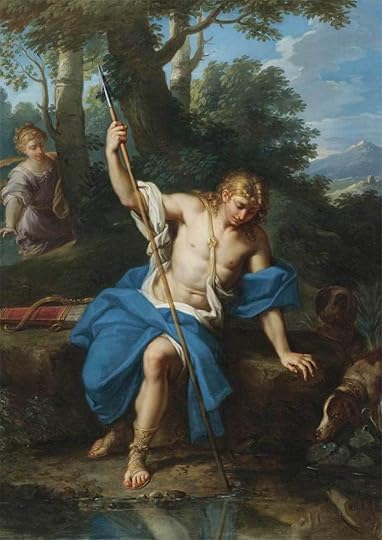
 Roman Clodia wrote: "For those of us who are interested in tracing this poem's engagement with issues of gender and speech, the Echo/Narcissus story is fruitful. Echo, having lost her own voice for the 'sin' of speakin..."
Roman Clodia wrote: "For those of us who are interested in tracing this poem's engagement with issues of gender and speech, the Echo/Narcissus story is fruitful. Echo, having lost her own voice for the 'sin' of speakin..."Thank you, Clodia.. Yes, I am very interested in this theme.. I was about to post on Echo's loss of speech - one of the themes I am following.
Echo seems to suffer two misfortunes - the first is a punishment inflicted by Juno (her voice becoming a repetition of someone else's) but then she loses her body too ... it wastes away.. If I am not mistaken this second misfortune is an indirect result of Narcissus not paying attention to her - she just withers away. But I may have missed something.
 Roger wrote: "
Roger wrote: "Elena, I did not know of the Cellini, but have since found it. Thank you. It is ..."
Cellini could qualify as another Narcissus himself... His Vita is a great read.
 A very different Narcissus...
A very different Narcissus... >
>I don't know where the colour version is but there is a b&w print in the BnF.
Honoré Daumier. 1842. BnF.
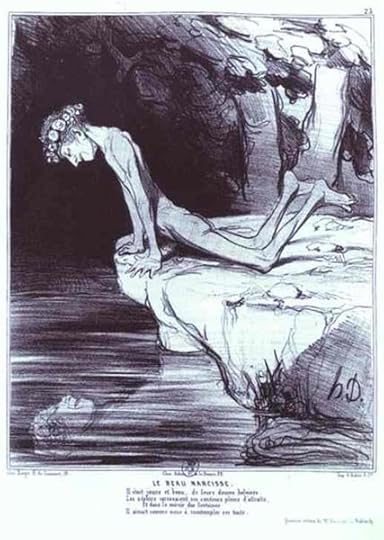
 Jim wrote: "he may well have served as his own model for that painting -- and perhaps for his Bacchus as well...."
Jim wrote: "he may well have served as his own model for that painting -- and perhaps for his Bacchus as well...."I wonder whether he is depicting himself, or one of the boys with whom he hanged around (Cecco?)
But if it were a self-portrait it would indeed be very interesting. For the subject of Narcissus looking at himself on the surface of the water can be considered also as a play with representation for artists engaging in self-portraiture. The theme can easily become a meditation on painting and on artistic identity - the real versus the represented - whether the image overcomes reality - and where is the true identity of the painter, in his own self or in his art.
Carvaggio's is a particularly interesting depiction, since Narcissus is about to fall into the pond looking at his right he is, inadvertently about to pose his left hand on the water...
 Another interesting Tiresias.. by the Japanese artist (I believe she is now British) Tsugumi Ota.
Another interesting Tiresias.. by the Japanese artist (I believe she is now British) Tsugumi Ota.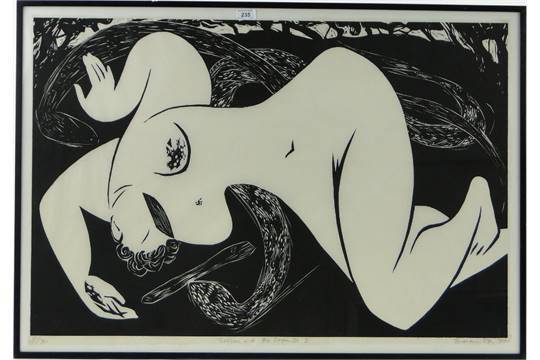
Such delicacy in its ambiguity.
 A lovely Tiresias by a follower of Flaxman.
A lovely Tiresias by a follower of Flaxman.After Flaxman. 1755-1826. Tate.
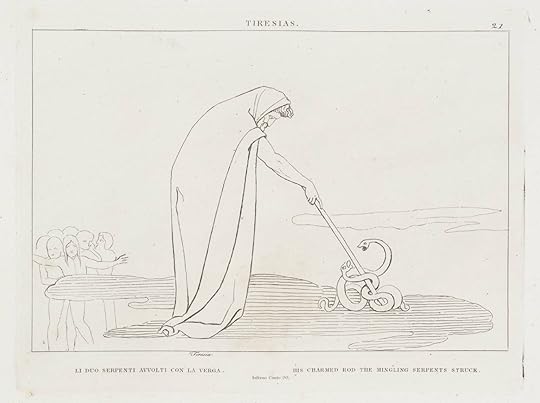
But Tiresias has another very interesting representation, with his head turned 180º. This comes from his appearance in Dante's Comedia.
Dante and Virgil meet him, tougher with other Seers such as Mphiaraüs, Aruns, and Manto (Tiresias' daughter and possibly the origin of the name of the city of Mantua), in the Eight Circle of Hell. The reason for their head being twisted this way is because Dante did not consider them true Seeers - since they did not get their gift through revelation.
Priamo della Quercia. 15C. British Library.
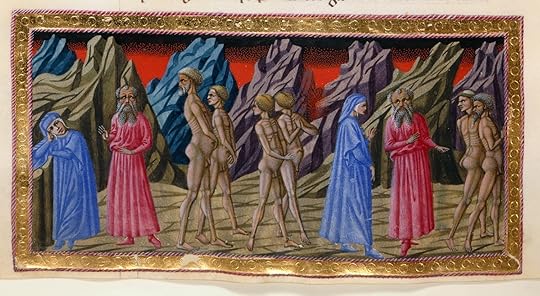
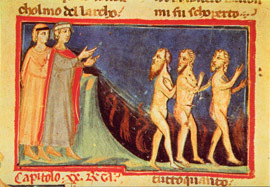
 Elena, here is the painting
Elena, here is the painting Deshahys de Colleville. ca 1760. Norton Simon Museum.
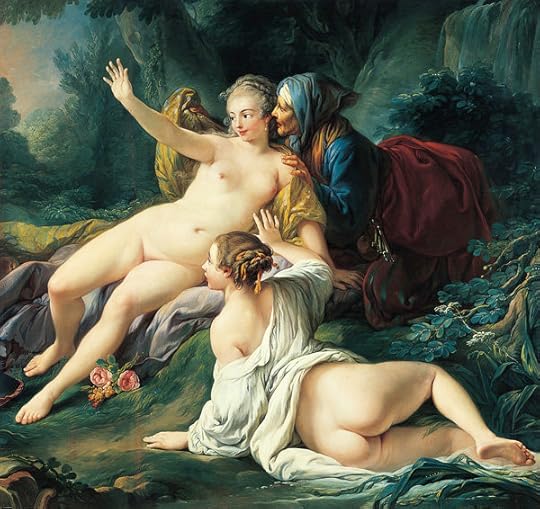
Yes, the ability to show the various sides of the nude was greatly appreciated... On one hand the painter could strive to rival sculpture but also
It seems that during at least during the 16C the backside of women was considered particularly voluptuous. This idea comes from the correspondence between Titian and King Philip II.
 On the Birth of Bacchus...
On the Birth of Bacchus... We have an interesting version by Giulio Romano.
As the Giants that Fionnuala posted earlier, this painting was also for Federico Gonzaga for his Mantuan Palazzo del Tè.
We see Semele beginning to burn, Juno at the top left looking still like an old woman, Jupiter somewhat horrified again by what his wife is capable of doing, baby Bacchus and I presume Ino is the lady at the far left, dressed in pink and green, or the one kneeling down holding Bacchus. I would have liked to see how a painter dealt with the baby being carried by Jupiter in his thigh...!!!
Giulio Romano. The Birth of Bacchus. 1530. Getty.
